The 20th Century Status Quo
The 20th century status-quo of American-Canadian relations was a very good one. To Americans, Canada as a friendly, prosperous, and stable neighbor to the north, closely related by blood, culture, and history. Geopolitically, Canada was joined at the hip with the United States, and had a high standard of living and close economic integration. This was a mutually beneficial relationship; the US didn’t need to worry about our northern border while Canada could free-ride on American military protection and had access to the world’s largest economy. Not for nothing do Canadians tout the American/Canadian border as the largest undefended land border in the world. Unfortunately, this status quo has been jeopardized by recent changes to Canadian immigration policy, which are on-track to wreck a century-long partnership.
Immigration
It is difficult to overstate the disaster that is Canadian immigration policy. Since the 1980s, Canada has had higher immigration levels than the United States. After taking office in 2015, the Trudeau government doubled this already high level to the extreme level of a half million per year (in a country with less than 40 million people, about four times the immigration level of the United States). Then after COVID, Trudeau more than doubled Canadian immigration again, to 1.25 million per year (about ten times US immigration levels!).
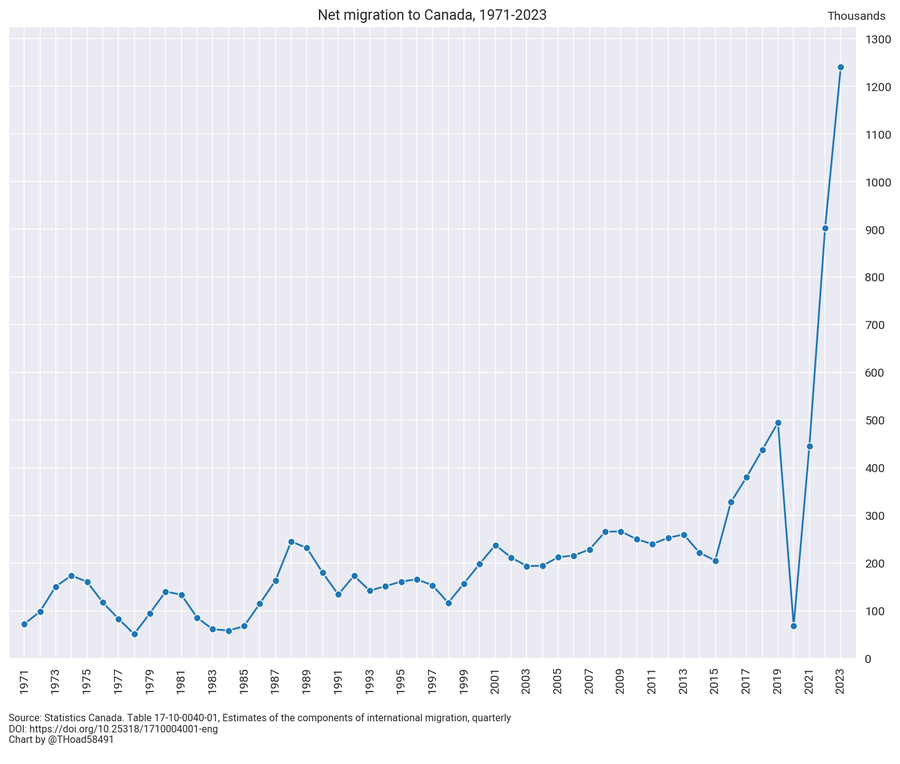
The composition of this immigration has also changed dramatically over time. Before 1980, the overwhelming majority of immigration to Canada was from Europe, of people who looked and acted similar to ethnic Anglo- and French-Canadians (and often from nearly-indistinguishable Britain and France) and thus were easily assimilable. But since 1980, most immigration to Canada has been from Asia.

One country in particular stands out. A full third of all immigrants to Canada in 2021 were Indian, four times more than the next highest country, China. This sort of dominance of immigration by one country makes assimilation, already very difficult under the best circumstances due to the importance of genetics, impossible, as it’s trivial to form ethnic enclaves, and is the reason country caps exist in the US immigration system.

Unlike the United States or Europe, where the large majority of immigrants are illegal, refugees, or brought in through family reunification, Canadian immigration is designed to be selective and aid the economy. Most permanent Canadian immigrants are granted that status through employment, while (supposedly) temporary Canadian immigrants are about ⅓ students, with the remainder on employment visas. I say supposedly because while ostensibly temporary, this group makes up a full 7.3% of the entire population of Canada, and there’s no plan or mechanism to remove them from the country. And Canada has birthright citizenship, giving ostensibly temporary migrants an easy path to permanent residency and citizenship through anchor babies.

Canadian immigration is intended to be selective, to vacuum up the world’s human capital. And it largely succeeds! Along with Australia (which has a similar policy), Canada has the world’s smartest immigrants (though note that the PISA tests 16 year-olds, and as such the less-selective Trudeau wave, which would almost certainly change the picture, is not getting picked up here), approximately on-par with native-born Canadians.

So Canada has a (successfully-executed) policy of truly gargantuan numbers of majority-Asian, plurality-Indian legal, skilled immigration designed to aid the economy. This approach has been explicitly endorsed by multiple immigrationist intellectuals, such as Tyler Cowen, Alec Stapp, Noah Smith, and Matthew Yglesias, and is analogous to proposals to remove country caps on employment visas1, increase the number of H1-B temporary visas granted, and staple green cards to college diplomas in the United States. How has it worked out?
Because of how closely integrated the two economies are2, Canadian growth closely tracks American growth, or it did until 2015. Since Trudeau entered office and first doubled and then quintupled immigration, living standards in Canada, relative to the United States, have plummeted.
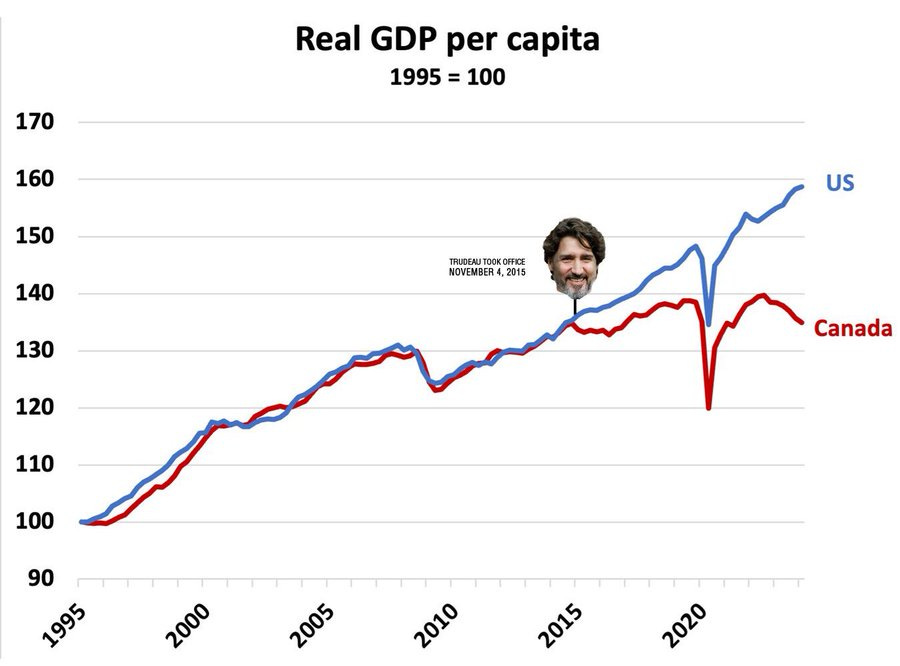
It’s unsurprising, then, that even oil-rich Alberta has lower wages than every US state, even West Virginia with no major urban center or the Deep South with its large black population.
Some of this is lack of capital. Capital per worker is one of the strongest predictors of productivity, and the enormous influx of workers without capital has predictably eroded Canadian labor productivity relative to the United States.

And the effect on standard of living is even worse3, because a colossal and sudden increase in demand for housing, concentrated in a handful of already-expensive urban centers4, has also caused Canadian housing prices to explode. Real estate prices are counted as GDP, but for those Canadians who are not landlords or developers this is a cost, not a benefit5.

Given Canada’s extraordinary housing costs and low wages, it’s not surprising that Canadians also suffer from incredibly high household debt.
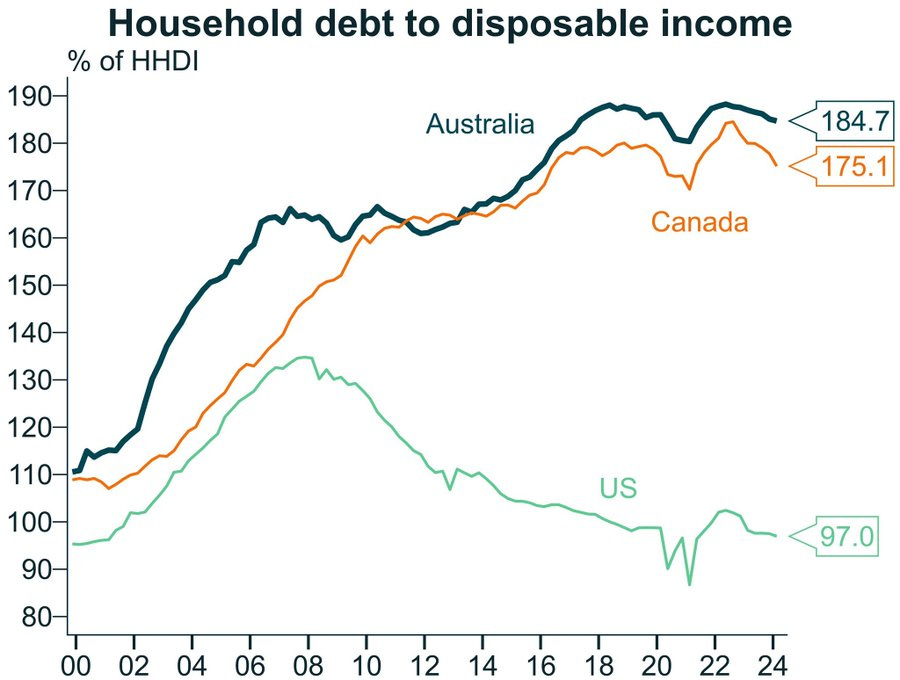
Canada’s not just an economic disaster zone. It’s managed to heavily skew the sex ratio among the young. Skewed sex ratio is widely recognized as a huge problem in Asia, because it encourages women not to marry until later (by increasing optionality), ensures many men will be alone and those that are not will have lower bargaining power, and increases crime. South Korea, China, and India all put themselves in this position through decades of sex-selective abortion, but the Canadian government has inflicted it upon itself through immigration.

Both skewed sex ratios and high housing prices lower fertility on the margin, so it’s not surprising that Canadian fertility, for centuries among the highest in the West, has taken a sharp turn for the worse both absolutely and relative to peers.
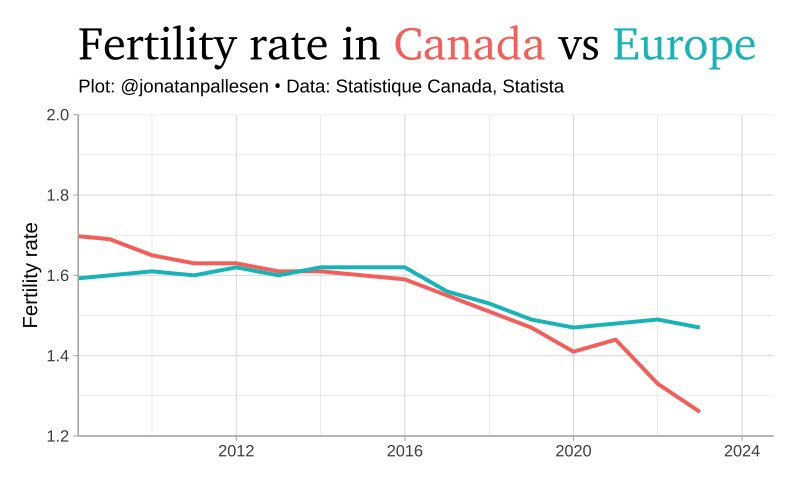
This is a big deal; the difference between a TFR of 1.6 (where Canada would be if it retained its pre-2012 TFR advantage over Europe) and a TFR of 1.24 is a factor of two in three generations. One is bad, but can be dealt with with gradual adaptation and marginal improvements, the other is an existential crisis.
What makes this all particularly absurd is that Canada has the highest national IQ of any non-East Asian country and one of the largest natural resource endowments in the world.
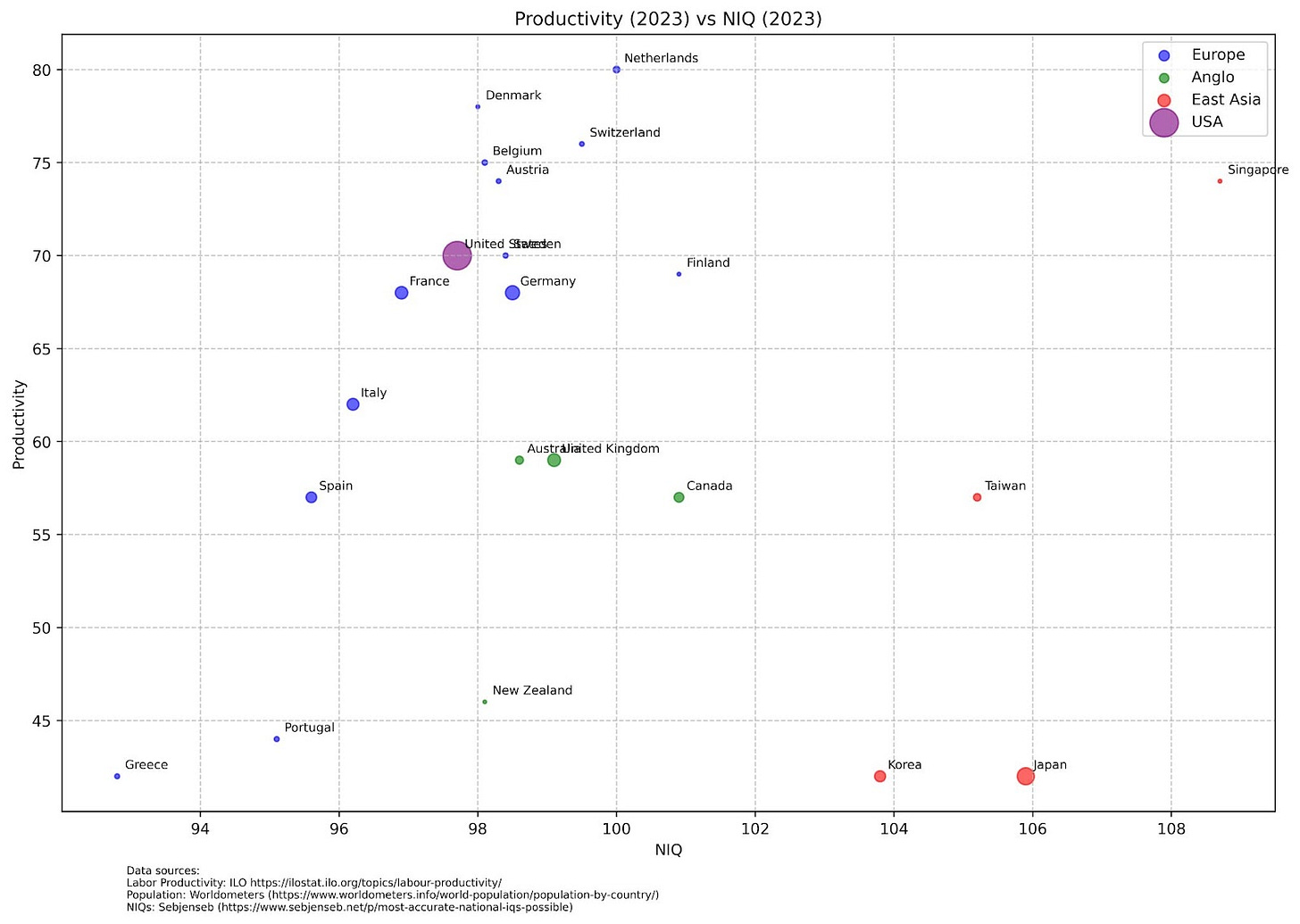
Enormous resource rents plus a tiny population plus having sovereignty guaranteed by the United States is an enviable position to be in. With merely adequate government, Canada could easily have the highest standard of living in the world, an Anglo-French North American Norway or Qatar. But instead of leaning into this, the grand strategy of the Canadian state has, like Britain, been to specialize in low-skill labor-intensive services, real estate, and degree mills6 while legally penalizing resource extraction.
The result of this catastrophe is that Canada is no longer the country of America’s imagination. Rather than America’s calmer, nicer, but slightly less prosperous cousin, Canada is quickly becoming far poorer and a worse place to live. Illegal immigration from Canada used to be nearly nonexistent; why take the risk when you’re already living in a perfectly nice First World country? But with a falling standard of living and an enormous number of people with no non-financial attachment to Canada, this has changed. Since 2020, nearly half a million illegals have been caught crossing the northern border.
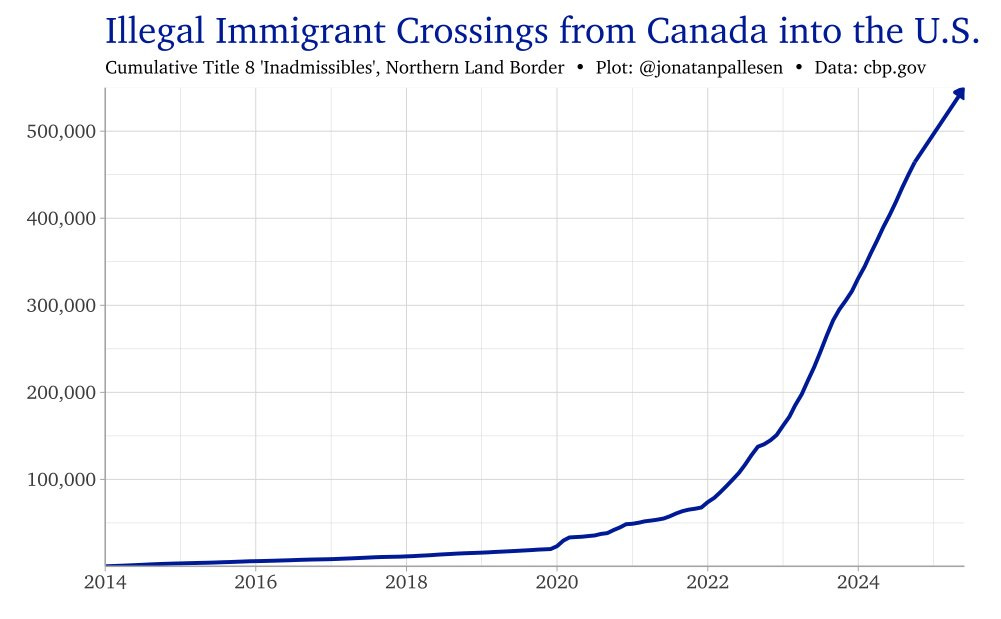
Canada is quickly becoming Mexico II. The Mexican border is a disaster; not only is it a huge source of drugs and illegal immigration, but the security measures in place to prevent these also add more friction to licit movements of goods and people. Allowing the northern border to turn into a much larger clone, which it is on track to become within a generation, would be a colossal failure of American statesmanship. Right now, this can still be stopped, but the window will soon close.
Geopolitics
Immigration hasn’t just destroyed the Canadian standard of living, it’s also changed Canada’s geopolitical stance from reliable American ally to (aspirational) independent great power and (actual) base for foreign influence on the North American continent.
Canada’s status as an effective American protectorate benefits both parties, but some of Canada’s elite aspire to independent great power status and sees immigration as a path to it. The logic is that with 1/10 of America’s population, Canada must accommodate its larger southern neighbor, but with ¼ or ⅓, would have much more leverage to act against US interests. This is wrong because people are not interchangeable; Canada with the population, prosperity, and stability of Mexico, as this level of immigration is on track to deliver, can harm the USA but not oppose it. But the aspiration alone is a hostile act against the United States and should be treated as such.
More importantly, the Canadian government is riddled with foreign agents, to the point that the ruling party refuses to release the names of parliament members working for foreign powers7 (probably because they would all be immigrants). Unsurprisingly, immigrants do not generally give up their foreign allegiances unless forced to (leading to absurdities such as the Sikh foreign minister directing Canadian troops to evacuate his coethnics in Afghanistan rather than prioritize Canadians), and the explicitly post-national Canadian state has no interest in doing this. India and China, the two largest sources of immigration to Canada, both use their diasporas as a tool of foreign policy, and Canada’s descent into a playground for foreign interests benefits them most of all. US political consensus on China is that it is an adversary that needs to be competed with, which is not compatible with Chinese influence in Canada. American relations with India8 are less adversarial, but, as in the Cold War, India is still a broadly neutral independent power rather than friendly (especially given Indian support for Russia in the Ukraine war).
Allowing Canada to become an independent geopolitical actor, as Canadian immigration policy is intended to achieve, or the tool of India and China within North America, as is actually happening, would turn back the US’s geopolitical position a century, from unchallenged domination of our near-abroad to once again locked in a contest for North America. Again, this can be stopped, but not for long.
What is to be done?
The supreme function of statesmanship is to provide against preventable evils. The United States should act quickly to prevent Canada’s decline into a Third World playground for foreign powers, before it’s too late. There are a number of options available: continuing the status quo, demanding major concessions and locking them into law or treaty, breaking up the confederation, or annexation.
Status Quo
The easiest path for the United States is to do nothing or demand symbolic action on border security. This is attractive because it will stop the collateral damage of Canadian immigration on the length of an election cycle and doesn’t require rocking the boat, but crucially doesn’t solve the problem of Canada’s slow descent into a hostile Third World country. And any such actions will be rolled back with the next administration change; it’s not a permanent or even long-term solution.
Concessions
Fortunately, Donald Trump has repeatedly proven that he doesn’t mind rocking the boat with Canada. If he’s willing to threaten 25% tariffs over cross-border fentanyl alone, he should be much more willing to threaten them over much more important questions like Canada’s long-term status. The United States government can use its power to demand concessions on immigration. A good target would be requiring that Canada reduce immigration levels by 90% or more to bring them in line with per-capita US levels or lower, sealed by Canadian law or treaty (perhaps with automatic mechanisms to restore the tariffs if the Canadians renege).
To make this less straightforwardly coercive, it could be accompanied by a carrot such as freedom of movement between the United States and Canada. Demanding Canadian immigration restriction as a prerequisite of freedom of movement makes sense; the Schengen zone in Europe shows both the benefits of freedom of movement between First World countries and why it requires harmonization of immigration policies. Without harmonization, the least restrictive member decides policy for the bloc as a whole. Freedom of movement without Canadian immigration restriction would be a disaster, as millions flood Canada’s extremely lenient system as a stepping stone to the wealthier United States.
Once committed to pressuring Canada to change domestic policies, we should also take the opportunity to demand Canada eliminate its extreme and tyrannical censorship regime and affirmative action policies. These policies are bad for Canadians (and, since Canadian quality-of-life is an American interest, for Americans) and, because ideas easily cross borders, strengthen the establishment left across the Anglosphere9.
This course of action would be a win-win for both the United States and Canada. I believe Canada is locked in a bad equilibrium wherein decision makers recognize how disastrous Canadian immigration policy is for the country as a whole (witness Trudeau’s recent backtracking), but are unable to do anything about it because the special interests that benefit from it (degree mill universities, cheap labor service industries like Tim Horton’s, real estate interests, and various ethnic lobbies - 44% of Canadian residents were immigrants or the children of immigrants in 2021, and that number is now significantly higher) are too powerful. Public US pressure would give the incoming Poilievre administration cover to massively restrict immigration without alienating these groups.
This is the minimum viable plan for restoring the 20th century US-Canada status quo, would benefit both parties, and could be done without permanently burning bridges with Canada, and so the Trump administration should take this as the default course of action.
Fragmenting Canada
If pressuring the Canadian government off their course of national suicide fails, another option is to minimize the damage. The Canadian confederation has always been a fragile and unwieldy union, with no equivalent to the US Civil War to meld the provinces together. Economically, geographically (the only trans-Canadian railroad is regularly cut by activists), and culturally, Canada is far less united than the United States, and fragmentation is a real possibility. If Canada cannot be stopped from committing suicide, the United States can limit the damage by doing the following:
Offering US statehood to Alberta. Alberta is the most right-wing and pro-American Canadian province, with enormous oil wealth, and funds the rest of Canada via equalization payments. Alberta would benefit by no longer having to subsidize a much poorer country, while rump Canada would be gravely weakened financially and geographically disconnected.
US territory status for Canada’s sparsely populated northern territories (Yukon, Nunavut, and the Northwest Territory). Alternatively, they could be annexed to Alaska. The argument here is the same as Greenland; these territories are economically worthless but militarily valuable, (with the potential to become much more so depending on the impacts of global warming on Arctic sea ice) and essentially empty. This would also help encircle rump Canada.
Support independence for Quebec and Newfoundland (the most pro-independence provinces) with carrots such as immediate recognition, replacing Canadian equalization payments (cheap for the United States), and free-trade and security agreements.
The benefits would be additional territory and natural resources for the United States, an end to Canadian aspirations of geopolitical independence, and a much easier time pressuring multiple smaller and more dependent North American states to reduce immigration. If it could be done, this would be better than the previous option because it would greatly limit future Canadian government’s freedom of action to renege on immigration deals.
The problem is that the success of this approach is entirely dependent on internal provincial political dynamics and fomenting separatism is a hostile act. The US taking a pro-separatist stance would torch what’s left of relations with Canada10, to potentially no benefit if provincial leaders decide to keep the confederation together or if independence or annexation referendums fail. I believe it’s worth unofficial, plausibly-deniable behind-the-scenes overtures to the leaders of the above-mentioned provinces, but that the United States government’s public stance should not be to encourage separatism until there’s no other choice.
Annexation
Trump has also floated the idea of annexing Canada wholesale. This idea has circulated in American elite circles since the failed revolutionary war invasion, and the benefits to America are obvious: unrestricted access to the entire northern third of the continent, with enormous and sparsely-populated tracts of land and natural resources, plus the elimination of what trade and political barriers (such as tariffs against US agricultural goods) between the two countries remain. More importantly, it would permanently solve Canadian decline: the Canadian government would disappear and cease to be able to demographically vandalize North America. I also believe this would be good for the welfare of individual Canadians, who suffer under an unusually dysfunctional government and would benefit from American rule, plus it would open the door for many to migrate southwards. It would be one thing if the Canadian government was using its sovereignty to benefit its citizens through exploitation of natural resource rents or better policy, but it is doing the opposite.
That being said, the problems with annexation are huge and glaring. Neither the Canadian government nor Canadians as a whole want to be part of the United States and Canadians do not like America. Annexation of Canada as a whole would probably require war, which is not worth it. Open political systems are not well suited to conquering foreign peoples11, as they give the conquered power over the conqueror, and it’s not worth rolling the dice to see if Canadians are foreign enough to qualify12. And even if it could be done peacefully, Canadians are extremely left-wing relative to Americans. I think full exposure to the US media ecosystem and political environment (and the destruction of the Canadian censorship apparatus) would change this eventually, in much the same way that Britons and northwestern Europeans in the US are right-wing relative to their cousins in Europe, but it could take a generation. A generation of left-wing dominance in the United States would wipe out the benefits of Canadian annexation (economically and demographically) many times over; rather than us spreading our system to them, we would get convergence of both.
Conclusions
American policy towards Canada should focus on keeping Canada stable, prosperous, and allied. Canadian immigration policy undermines all three. Dealing with this is well within the power of the United States government, but not forever. If Canada declines to the level of Mexico, there will be no recovering the situation. President Trump should act to stop the Canadian government from completing their national suicide, or failing that limit the damage by breaking up the confederation.
Which would lead to total Indian dominance of this route because Indians are ~60% of the backlog, not only increasing the Indian number but crowding out every other group since there is a fixed number of visas.
Economic integration does not imply full convergence, but it does imply that growth should be similar between countries, because otherwise capital will flow into the country with higher growth opportunities until the marginal investment in both is the same.
It’s not surprising that the Canadian Liberals, like the British Tories who pursued a similar policy after Brexit, are on track to get completely wiped out in the next election. Republicans take note.
One argument I’ve seen when discussing Canadian immigration, both in real life and online, is that it’s a good thing because Canada is extremely sparsely populated. This ignores the fact that immigrants today are not hardy Swedish farmers out to settle the frontier; they’re moving straight to the biggest urban centers like everyone else. It’s not the 19th century any more.
This is obvious for renters and anyone paying mortgages, but it applies to homeowners too: even if your house appreciates, you need to sell it and live somewhere else to actually gain from that, which means you’re only getting rich if your house differentially appreciates.
This is very similar to Britain, and it’s not an accident that, despite Canada having the cheapest energy in the OECD while Britain has the most expensive, both countries have been economic disaster zones in the past decade.
Americans can’t be smug about this, given our inability to remove the likes of Ilhan Omar, here to represent Somalia, from the country. But it’s a matter of degree.
There’s also the fact that the Indian diaspora is very heavily Sikh and Canada has become the world center of the Khalistani movement. This has led to multiple assassinations on Canadian soil (by the Indian government, with attendant diplomatic incidents) and a number of terror attacks. As a result, Canadian relations with India, rather than being friendly or neutral, are actually hostile, for reasons that have nothing to do with the Canadian national interest. This complicates the picture, but doesn’t change the main point. By virtue of being a close American ally, Canadian hostility or friendliness towards India as a result of diaspora influence is bad for the United States.
With this in mind, this should be a cornerstone of US policy towards Australia, Britain, and New Zealand as well. These are less critical to American safety, but their status as heavily-censored extremely left-wing redoubts in the Anglosphere still threatens the long-run interests of the United States.
Well, probably. The British government is remarkably tolerant of outsiders supporting Scottish independence or the annexation of British overseas territories by Argentina and Mauritius. But anti-Americanism is core to what’s left of Canadian identity; I think stances the Canadian government would be happy to accept from China or India or Nigeria would draw a sharp and hostile reaction if they came from the United States.
Historically, United States acquisition of sparsely-populated territories which are then peopled by the demographic expansion of ethnic Americans, as in the Lower 48 and Alaska, has gone well, while conquest of other peoples, such as in the Philippines and Puerto Rico, has been somewhere between a waste and a disaster.
Annexation attempts can easily backfire by catalyzing differences that were minor before, as Putin discovered with Ukraine.



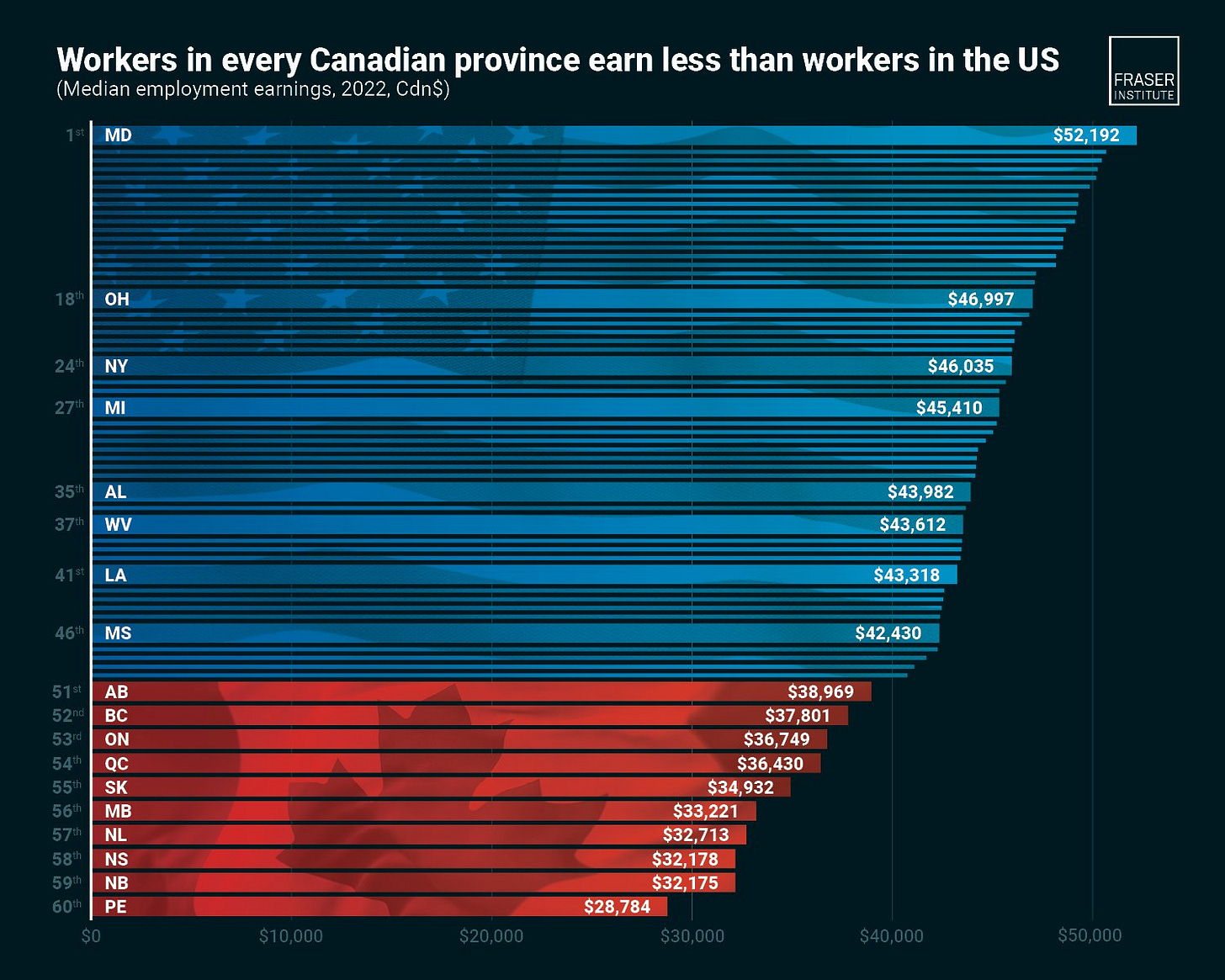
Very good and true but you understate or omit a few things:
1. 25% of Canada's immigrants are family reunification immigrants, often elderly and medically needy, socially dependent, relatives.
2. Canada's public medical system has been failing slowly, like every communist project on a large scale, but is being crushed now under the weight of mass immigration. Welfare state meet immigration.
3. Canada allows in 200,000 almost refugees annually. They are not genuine refugees in origin and it is a sort of sneaky and disheveled immigration route. They are takers, not makers.
Canada is failing - visibly and probably irrevocably at this stage.
The thing I love most about your posts are the well-supported-yet-counterintuitive takes.
"High IQ asian immigrants are bad, actually." (because they don't assimilate or innovate as much)
"Yes, Canada has done immigration better than basically every other country in the world, but it's a basket case in the making and should be annexed or brain drained to save it from itself."
That prime "single and dating age" gender imbalance is crazy if true, too - on the order of China or India, and having lived and done business there for years, dating SUCKS for regular Chinese guys, women won't even date you in a major city unless you own a house and car, which is on the same order as owning SF or NYC real estate as a barista.